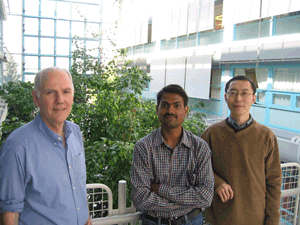|
|||
Assessing Quality of Service on the Internetby Peder J. Emstad Everyone who uses the Internet and mobile phones has an interest in their quality of service. We may notice delays when we browse the Web and transfer files, and we may wonder if our transactions are secure or if we can connect at all. New services, such as voice and video, are constantly being offered based on packet-switching technology, but provide varying quality for the user. A new centre at the Norwegian University of Science and Technology has been established to determine how to assess this quality of service. Traditionally, telecommunication networks have been established to transport voice sig-nals between geographically disparate users, and for that purpose a worldwide network, albeit of widely varying technical quality, has emerged. However, the days of networks dominated by analogue voice signals are long gone. Today's network of networks, the Internet, has become the general vehicle for the transport of digital data representing all kinds of information and information services. These services are realised through the exchange of digital data between end-users, and between end-users and service providers. They cover most aspects of human activities, both private and professional: general information exchange, e-mail, voice and multimedia services, transfer and storage of medical information, economic transactions, location information – the list is already seemingly endless. In the industrialised world, everyday life as we know it would cease to exist if the Internet were to become permanently inoperable. In order to address the problem of Quality of Service (QoS), the Centre for Quantifiable Quality of Service in Communication Systems has been established at the Norwegian University of Science and Technology. Research will be based around the continued evolution of packet-switching techniques for mobile networks and the Internet . Society's use of and dependence on such networks increases steadily, even though the QoS in a broad sense is unsatisfactory and at best variable. Services to be considered include traditional teleservices, multimedia, messaging, Web and information services, and location- and content-aware services. QoS as perceived by the users is a combination of factors, and relates to user expectation and satisfaction. It addresses quantifiable technical qualities and solutions, but other aspects such as billing and service management are not included. User (or source) and network behaviour and interaction in a broad sense are determining factors. To assess QoS it is necessary to thoroughly understand underlying network architecture, to make models and case studies, and to perform measurements. Research will therefore also assess methods and techniques. Furthermore, insights from the research will lead to improved technical solutions and strategies for network and service management. This will mean users can be guaranteed services without undesirable side effects. The Centre was established on 1st January, 2003 and now includes six post-docs, fourteen PhD students, and seven professors, one of whom is a visiting academic. The Centre hosts two ERCIM fellows (see Figure).
The Centre is financed by the Research Council of Norway, the Norwegian University of Science and Technology (NTNU), and UNINETT, the network operator and service provider for all educational and research organisations in Norway. Financing has been secured for five years, and may be extended for another five years. Telenor is also supporting the Centre, both financially and otherwise. The professors at the Centre are employed either in the Department of Telematics or the Department of Electronics and Telecommunications at NTNU. The Centre shares labs with the above-mentioned departments. In addition, UNINETT has made available laboratories, testbeds and advanced instrumentation for network measurements. The Centre is located on the premises of the Faculty of Information Technology, Mathematics and Electrical Engineering at NTNU in Trondheim. Trondheim is in the central part of Norway and offers excellent working and living conditions. The Centre works within the areas of multimedia signal processing, dependability, traffic and security as applied to multiparty communication. Theoretical studies will be undertaken based on analytical models, simulations and laboratory tests. Theoretical results can then be verified using the unique laboratories available to the Centre for experimentation The idea of the Centre is to look at overall QoS in packet-based communication networks like the Internet. This is equally important for audio and video encoding, as is handling of these flows in the network, where they can suffer delays and losses. This can be due both to high traffic and to breakdown of equipment. Excessive traffic may be due to junk mail or hacker attacks, and for a user there may be a subtle difference between reliability and security. Indeed, QoS-relevant issues may be very entangled and should be studied as a whole. The Centre is a member of EuroNGI, a Network of Excellence under the EU 6th Framework Programme working with problems related to the design and engineering of the Next Generation Internet. It will be represented at COST 276 - 'Information and Knowledge Management for Integrated Media Communication' and is a member of COST 290 – 'Traffic and QoS Management in Wireless Multimedia Networks'. Link: Please contact: |
|||



